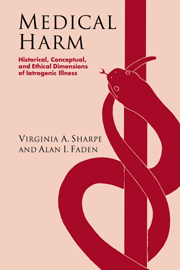Book contents
- Frontmatter
- Contents
- Acknowledgments
- Introduction
- Part I
- 1 Divided loyalties: harm to the profession vs. harm to the patient
- 2 Medical epistemology, medical authority and shifting interpretations of beneficence and nonmaleficence
- 3 Medical harms and patients' rights: the democratization of medical morality
- Part II
- Part III
- Appendix
- Bibliography
- Index
1 - Divided loyalties: harm to the profession vs. harm to the patient
Published online by Cambridge University Press: 22 September 2009
- Frontmatter
- Contents
- Acknowledgments
- Introduction
- Part I
- 1 Divided loyalties: harm to the profession vs. harm to the patient
- 2 Medical epistemology, medical authority and shifting interpretations of beneficence and nonmaleficence
- 3 Medical harms and patients' rights: the democratization of medical morality
- Part II
- Part III
- Appendix
- Bibliography
- Index
Summary
Recent scholarship in the history and sociology of American medicine provides a compelling account of how the professional authority of physicians was consolidated in the mid-nineteenth and early twentieth centuries. This consolidation occurred both by chance and by design. The introduction of surgical antisepsis (and later asepsis) and of diagnostic technologies such as the stethoscope, and X-ray as well as diagnostic tests, enhanced the credibility of the ‘regular’ physician and distinguished his abilities from the less demonstrative ones of homeopaths and botanics. This was also the most dramatic period of hospital growth in the United States. In 1873, there were 178 hospitals and by 1910 there were more than 4000. The role of physicians – and especially surgeons – was essential to this growth, for it was surgeons who provided the patients to fill the ever increasing number of hospital beds. By the late 1920s, surgical admissions outnumbered medical admissions by almost two to one. Further, as the public began to respond to the promise of surgical cures, the availability of surgical resources provided the all important argument for the advantage of hospital over home care. During this period, the hospital as a social institution was changing dramatically. In the early 1800s, hospitals were essentially charitable institutions, indeed, almshouses for the ‘deserving poor’. A patient's admission to the hospital was based on an assessment by hospital trustees of the moral character of the potential ‘inmate’.
- Type
- Chapter
- Information
- Medical HarmHistorical, Conceptual and Ethical Dimensions of Iatrogenic Illness, pp. 21 - 35Publisher: Cambridge University PressPrint publication year: 1998



